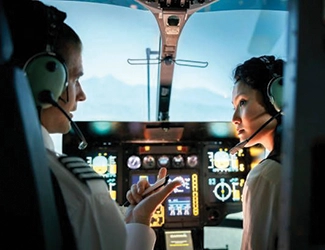 Lisa Archambeau,
Lisa Archambeau,
CAM, CFI
VP, Facilitator & Strategist,
ServiceElements
As a pilot, you most likely began your flying career training in a single-engine aircraft. Whether this was in the military (in which case thank you for your service), at an aviation university, or with a local flight school, you undoubtedly spent countless hours learning the skills and personal discipline required to exercise and maintain operational control of the aircraft.
 As you moved beyond single-pilot aircraft, the concept, tenets, and practices of crew resource management (CRM) came into play, introducing the sharing of responsibilities and cooperative decision-making into all phases of flight operation.
As you moved beyond single-pilot aircraft, the concept, tenets, and practices of crew resource management (CRM) came into play, introducing the sharing of responsibilities and cooperative decision-making into all phases of flight operation.
And then you joined the ranks as a business aviation pilot! You’ve been hired not only for your aptitude for flying, hours of experience, and possibly the type ratings you hold, but also for your attitude, temperament, and ability to be a team player.
As with CRM, being a team player requires great communication and cooperation. However, many aviation professionals find that the type of communication required of business aviation teams relies on skills which were not taught in our initial technically-oriented training. For example, a second-in-command (SIC) on a Citation Excel observed that the pilot-in-command (PIC) was taxiing in at a rather high rate as they made their way to the FBO.
She tried to bring it up in a humorous way, quipping the takeoff roll callout of “airspeed alive.” The PIC laughed but continued the fast taxi, keeping it up until eventually and inadvertently winding up parked a few feet ahead of the intended spot, and actually up onto the chocks that were awaiting use after full stop. Despite feeling that the fast rate of taxi was dangerous, this SIC was not comfortable raising this as an actual concern.
It is imperative in the increasingly complicated environment of business aviation that team members trust each other enough to have honest conversations. When trust exists, people are free to admit mistakes and weaknesses, and to voice concerns without fear of reprisal.
While operating procedures are best standardized, it is not uncommon for techniques and personal preferences to vary among pilots. Initiating a conversation to both understand the other person’s perspective and get aligned on common goals – such as safety, company standard operating procedures (SOPs), and accident avoidance – would be more effective than making a joke and hoping they get the hint.
In another instance, a potentially serious situation arose with a Part 91 operator when a maintenance technician working near the nose of their turboprop aircraft stopped the captain, who was headed toward the stairs and planning to depart shortly. The technician informed him of a minor maintenance issue that needed attention before departure.
She showed the captain the issue and assured him she could take care of it while they performed their preflight activities, and would have it completed well in time for the flight. The captain agreed that there was no cause for alarm and was fine to proceed with the flight as planned. The first officer (FO), also an experienced captain, was already on the flight deck.
The maintenance work was completed, the passengers boarded, and the checklist was run. After takeoff, however, the captain casually mentioned being glad that the last-minute maintenance had not delayed them. In the exchange that followed, it became clear that the FO had been restocking the back and had no idea that maintenance was being performed. He had seen the captain walking around the aircraft to look at the maintenance issue, and assumed that he was performing the official walk-around.
This led the FO to think – mistakenly – that the required pre-flight checklist items had been completed. In reality, the pre-flight walk-around was never accomplished.
Thankfully, the flight had no issues and the crew did a thorough post-flight inspection after landing. However, both pilots agreed that the situation could have been avoided if the captain had shared what he assumed the FO already knew about maintenance being performed on the aircraft. The FO could also have checked his assumption that the captain had performed the pre-flight visual inspection.
It may be tempting to think that confirming a colleague has completed their work or checking that they are aware of information you have is showing a lack of trust. In truth, trust is being able to stop assuming, being willing to ask and be asked questions, and for each team mate to trust that those questions are coming from a good place.
Increasing our awareness of others on our team, respecting differences in thought, background, and experience, and appreciating their perspectives – even if you disagree – are the best ways to build trust. Let yourself be vulnerable with team mates, admitting your mistakes and weaknesses. And be open to your team mates doing the same. When you tell your aviation department mates what you need from them, are you also asking them what they need from you?
In my role at ServiceElements, I am thrilled and honored to help business aviation teams understand each other better and take a more active interest in their team mates’ perspectives, input, and concerns. With 23 years of helping business aviation organizations succeed, we offer training programs in communication, emotional intelligence, stellar customer service, and other team-building areas.